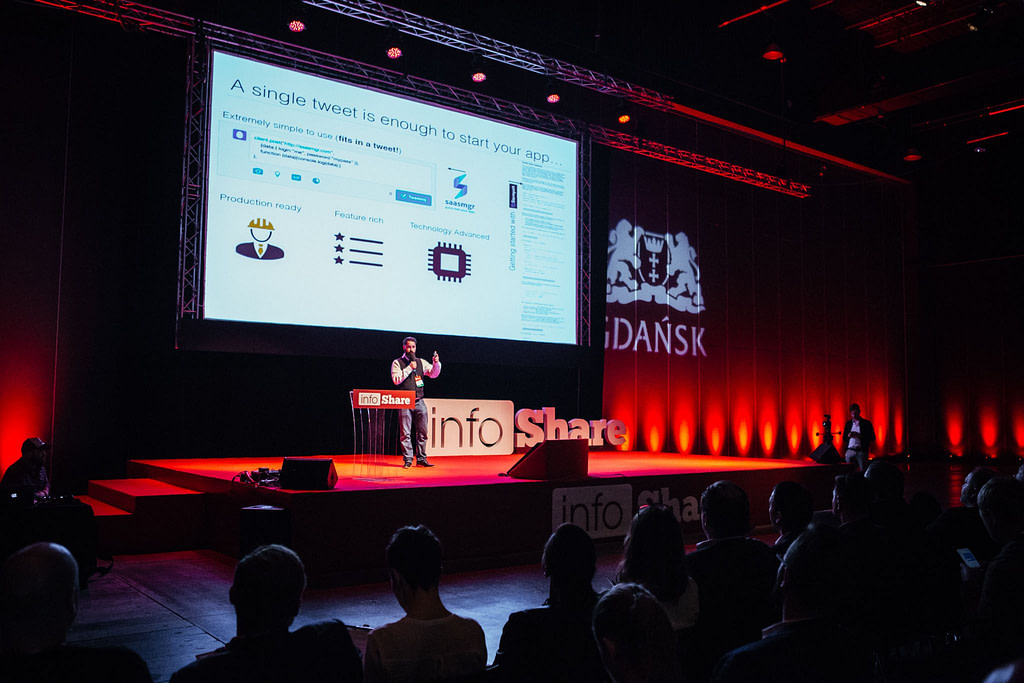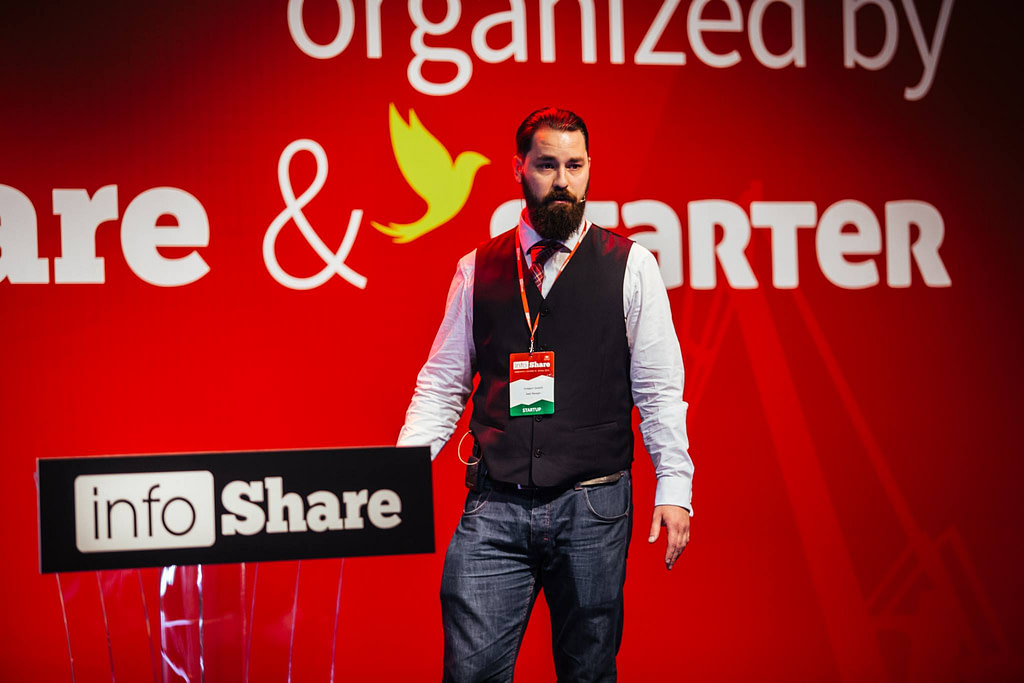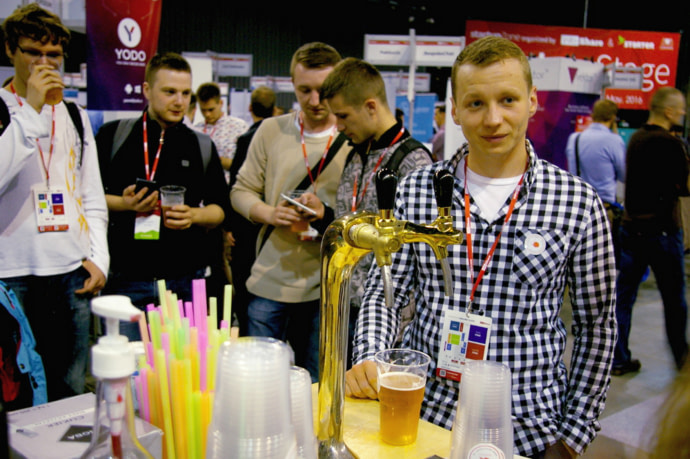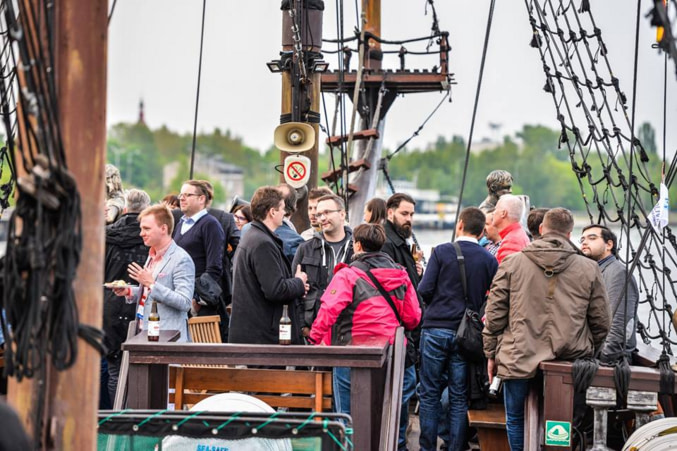InfoShare 2016 has given Neoteric a lot of opportunities but it was also a big challenge for us. For the first time, Neoteric and AmberHub have sponsored the event, which is the biggest and the most important start-up fest in CEE. We exhibited four start-ups: SkillHunt, SaaS Manager, SchematicLab, and Appoint.ly. All of them achieved a lot during this three days.
It’s time for a little summary, overview of our accomplishments and some conclusions for the future.

SaaSManager: How did we get to the finals and close a seed round during the conference?
For the first time in the history of infoShare, a Polish start-up has closed a deal with an investor during the conference. SaaS Manager – a platform that helps you build SaaS solutions faster, cheaper and better – has raised a seed round from FerberVC. “With this money, we will improve the onboarding experience for our customers, add important features and prepare for launching open beta” – said Greg Gwoźdź, CEO of this new venture.
“For the first time in the history of #infoShare, a polish #startup has closed a deal with an investor during the infoShare”
SaaS Manager got to the finals by winning the audience poll for the best start-up of the event, gaining more votes than all the competitors together. Here is how we managed to do that:
- We started to prepare months before the event. There is a long way between the first impression and the notary. Negotiating term-sheet, due diligence, getting papers through the process took weeks of work and waiting for decisions. When we got a text “we can see the notary tomorrow” right after we pitched during the finals, we had everything on paper.
- We pitched the right people and asked for the right thing. Gaining the interest of the biggest names at the event is hard. We knew that we needed more exposure to establish important relationships. For that, we aimed for the finals. There were 5 tickets given by the jury and 2 by the public. In case the judges didn’t choose SaaS Manager, we started raising votes from the public. We pitched SaaS Manager to every start-up, investor and attendee we had access to, convincing them that it’s worth to invest their virtual funds into our start-up. As a result, we got to the finals raising more virtual capital than all the other contestants together.
- We focused on engaging the right audience, not on winning the contest. SaaS Manager is a niche, technical solution that is not sexy. It’s very rare for such projects to win start-up contests that are not focused on their field. We knew that getting attention from the right audience was more important to us than winning the contest. Greg has done a really good job engaging judges during his pitch and we gained interest from Amazon, OVH, Intel, Startupbootcamp and many other high profile targets.
- We leveraged our success. After confirmation from FerberVC and setting up the notary, we approached the organizers and shared the good news. This way information about the investment became a part of the official press release after infoShare 2016. That opened our doors in media that will help us spread the word about SaaS Manager.

What we can improve next time:
- Plan PR before the event – during every big conference there is a media coordinator. Approaching him with prepared press releases improves your chances of getting attention from the media.
- Get more feedback and improve the pitch – after the pitching session, judges have some insights not only into your project but also about the way you pitched. Asking them for feedback and adjusting the pitch can give you some extra points in the next round.
- Approach the judges earlier – most conferences publish a list of judges. Getting through their social media profiles, approaching and asking for feedback before the contest can help prepare a good pitch.
How and why did we engage attendees?
“Still with some creativity and empathy, instead of being flashy, you can engage the right attendants by offering them what they really need.”
I was surprised by how many start-ups with great ideas just sat on their chairs and waited for people to come. When we go to a conference, there’s much more to do than we have time for. Keeping that in mind, we knew that we needed to attract people. It’s hard to stand out as a start-up when there are big brands like Amazon, Intel or ASUS. They are able to spend big bucks on their stands, preparing escape rooms, contests with valuable prizes and so on – and you can’t compete with that (yet). Still, with some creativity and empathy, instead of being flashy, you can engage the right attendees by offering them what they really need. Here’s what we did to get the exposure we wanted:
- We had coffee and donuts. I have never been to a conference where there was no line for coffee. Whoever has a coffee machine is a hot target, especially in the morning. This gives you a lot of opportunities for conversations.
- We had cold beer. Fancy lemonades are sexy but nothing beats a cold beer. Not the day after the networking party. Having the right treats at the right time got us to hear that we are “the most empathetic team at the conference”.
- We got out of our booths. Beautiful hostesses were inviting people to visit us. With the right perks at the stand, we managed to sign up more than 500 users and get several new customers for SkillHunt as well as get SaaS Manager to the finals.
- We targeted our communication. Instead of pitching every project to random attendees, we’ve been asking how we could help. This way we knew their needs and could tell if we can both benefit from getting together.

What we can improve next time:
- Test the approach – for developers we traded treats for sign-ups. Next time, we will test if generosity pays off better and give first, before asking.
- Set goals for everyone – only our hostesses had clear goals and measures of success; next time we will set goals for every team member.
- Create a pipeline – we’ve lost some leads because people who could push them through the funnel were busy prospecting; next time we will have a pipeline for processing leads during a conference.
How did we hack that work with networking?
It’s highly unlikely to close deals during events. There are only some exceptions like SaaS Manager and you will not see many of them. How to make sure you get the most out of the event? Prepare for networking! Some people have it in their blood, others freeze at the idea of reaching out to strangers. Here is what we’ve done to expand our network with some important contacts:
- We were where our desired contacts were. Expanding the network of investors and influencers is much easier when you can meet them in person.
- We negotiated our deal as a package and got VIP access to the venue. This helped us meet investors, keynote speakers and other executives.
- We didn’t try to sell. Networking is about meeting new people and finding out if you can help each other. This didn’t stop us from closing a few deals. Some companies found SkillHunt so exciting that we’ve been adding new job offers during the event.
- We focused on others. We asked how we could help. We gave introductions, feedback, and attention. We found out that people are more willing to help you when they see that you want to help them as well.
- We asked for help. When we met the right person, we asked for introductions, feedback, and advice. We made sure that it’s for the mutual benefit.
Networking is about meeting new people and finding out if you can help each other.
Mateusz Kurleto

What we can improve next time:
- Prioritizing. Generating sales leads, expanding the professional network, building key partnerships or getting exposure – different people can help you in different aspects of business. Next time, we will set up priorities to increase the effectiveness.
- Plan the introductions. It’s always easier to start a relationship with a warm introduction; next time we will make a list of possible introductions from our network during the event and decide who is the right person to handle them.
- Prepare for lead qualification. I always write on business cards but it’s ineffective. I forget most conversations and that makes it hard to follow-up personally and leverage new connections. Next time I will find a way to get more insights and start qualifying leads earlier.
Read also: Things to know before you make an app – 10 successful Polish startups share their advice
Summary
InfoShare 2016 has been a good lesson for us. We managed to achieve a lot more than anticipated and still found a lot of things to improve. I hope this helps you benefit more from the next event you attend. I know it will help us.
